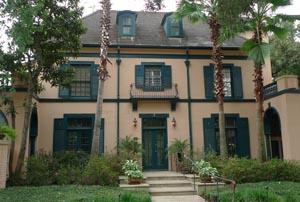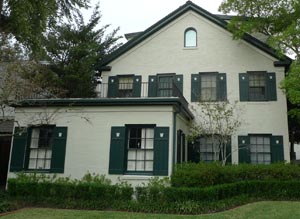



West Eleventh Place
History and Culture
The West Eleventh Place Historic District was designated as an historic district in 1997. It is significant for several reasons. First, West Eleventh Place was one of Houston’s first private planned communities. It likely served as a model for similar neighborhoods that were built in the following years. It is also significant because of architect Joseph Northrop’s use of the Colonial Revival style. He created smaller versions of country estate houses for elite, but not exceptionally wealthy, families. The district is also significant for its association with residents Dr. J. Willis Slaughter and Margaret Perkins Slaughter. He was an internationally renowned sociologist and psychologist who taught at Rice University. She was a member of the Garden Club of Houston for almost 40 years. She was recognized nationally for her contributions to horticulture.
Significant Buildings and Structures
Joseph Northrop designed the first three houses that were built in the neighborhood. Along with a fourth house built a few years later, they are all excellent examples of his interpretation of the Colonial Revival style.
Slaughter House, No. 4 West Eleventh Place, was built in 1921. Margaret Slaughter was a renowned gardener who is credited with introducing innovative methods and materials to gardeners in the Houston area. The property’s front garden retains its original planting scheme, although a rock garden has been removed. The house originally was built with a rear garden, as well, but that was removed in the 1970s to when the house was expanded.
Henderson House, No. 5 West Eleventh Place was built in 1921. The rear garage and service building was built in 1921 and expanded in 1948.
Averill-Ruby Blake Williamson Hargrave House, No. 6 West Eleventh Place, was built in 1921. Northrop rotated this house 90º so that it faces the house next to it, rather than the street. That gave the neighborhood more variety and made it seem more intimate. The Averills sold the house in the 1930s to Ruby Blake Williamson (later Hargrave). She was Thomas Blake’s widowed sister. Renovations in the 1950s changed the entryway and enclosed a terrace to create an additional room. The original two-story, rear garage with servants’ quarters is intact.
Bowles House, No. 2 West Eleventh Place, was built in 1923. The owners and P. A. Miller, the builder, designed this home in the Colonial Revival style favored by Mr. Northrop. The rear service building was also built in 1923.
Hail House, No. 1 West Eleventh Place, sits at the entrance to the neighborhood. It was built in 1925. The details on the front façade were inspired by French manor houses. The house was designed by architect William Ward Watkin. The original rear garage/studio building was also built in 1925. It was altered in the early 1990s.
Blake House, No. 7 West Eleventh Place, is located at the end of the cul-de-sac. It is a Spanish Eclectic style residence built in 1922. It was designed by the Norwegian-American architect Einar Stubee. The house is built with wood-framed construction beneath a plastered brick veneer. The rear service building and garage were constructed after 1960.
The entrance to West Eleventh Place at Bissonnet Avenue is flanked by two piers, built in 1921. They are constructed in red brick, with stone details, and topped with stone urns. Some subdivisions have piers like these as well as gates, but West Eleventh Place was never a gated neighborhood.
Notable Residents
The most prominent residents of West Eleventh Place were Dr. J. Willis Slaughter and his wife, Margaret Perkins Slaughter.
J. Willis Slaughter, Ph.D., was a sociologist and psychologist. He began his career as a lecturer at Clark University in Massachusetts. He then spent seven years in London working for the Sociological Society. At that time, the Society was concerned with town planning issues. Slaughter also worked in South America, New York City, and Philadelphia before coming to Houston in 1919 to teach at Rice University.
Margaret Perkins Slaughter was renowned in her own right. She had an enormous influence on domestic gardening and horticulture during the mid-20th century. She was a member of the Garden Club of Houston. The Garden Club had been started in 1924. Many of its members became highly regarded horticulturalists and botanists. They carried out research and experiments in their own gardens and shared that knowledge. Slaughter was particularly interested in bulbs. She founded the Garden Club’s Bulb Mart, which introduced many new bulbs and flowering shrubs to the general public. In the 1950s, Slaughter founded societies to promote the Spuria Iris and the Amaryllis, respectively. She wrote a booklet, “Gulf Coast Gardening,” that was (and is still) widely read. Slaughter received a national medal from the Garden Club of America in 1953 for achievement in botany. She was recognized in 1959 as Houston’s Gardener of the Year.
West Eleventh Place’s other male homeowners were businessmen. Thomas Blake (No. 7) was the founder and president of the Thomas W. Baker Lumber Company and vice president of the South Texas Hardwood Lumber Company. Both William Averill (No. 6) and William Bowles (No. 2) were executives of the Texas Exploration Company. Robert Henderson (No. 5) was president of the Henderson Cotton Company and later branched out into cattle, oil, land, and real estate. Egbert Hail (No. 1) was in the insurance business. Mr. Blake, Dr. Slaughter, and architects Northrop and Watkin were all members of Rice’s University Club.
The ladies of the neighborhood were active in Houston’s social, civic, and cultural affairs. Many of them were members of the Garden Club. They patronized Houston’s first important antique shop, The Shabby Shoppe, co-owned by Ruby Blake Williamson (No. 6). Antique collector Edna Henderson Bowles (No. 2) bought many things from the shop. After her husband died, Mrs. Bowles ran her husband’s oil business for 20 years, until her own death in 1965. Loise Jackson Henderson (No. 5) was related to both the Bowles and Blake families. Both she and Ellen Douglas Moseley Blake (No. 7) were graduates of the Kidd-Key College for women in Sherman, Texas.